
As we reported Tuesday, the FAA has taken the first steps to allow commercial use of unmanned aircraft systems (UAS) in what it referred to as the National Airspace System by granting limited exemptions from the Federal Aviation Regulations to six aerial photo and video production companies to use UAS below 400 feet AGL on closed sets. During a telephone conference, Secretary of Transportation Anthony Foxx, FAA Administrator Michael Huerta, and Motion Picture Association of America Chairman and CEO, former Senator Chris Dodd, outlined the exemptions that were granted, which included requiring the UAS operator to hold at least a private pilot certificate (it was not stated for what type of aircraft) and that the UAS always be within line of site of the operator. They said that these were the first steps in allowing the film and television industry the use of UAS on closed sets. Huerta said that the FAA is publishing guidelines for applications for exemptions that may be used by any individual or organization and encouraged applications. The exemption applications will be reviewed on a case-by-case basis and must show that the use is not a hazard to users, the public and national security. In addition, the FAA will have to approve the operating conditions for the UAS in the specific commercial activity.
The to-be-published guidelines, referred to as a “roadmap” by Administrator Huerta, are part, according to Secretary Foxx, of an effort across all nodes of transportation to balance access to new technology with the need to protect the public and national security. During the conference call, Huerta repeatedly referenced the new exemptions as only applying to the specific applicants and only for UAS operations on closed sets. When asked why a commercial pilot certificate was not required for the operator, Huerta explained that each proposed operation was examined as a whole-and the FAA’s conclusion was that on a closed set, holding a private pilot certificate met the needs of “the highest standard of safety.” Unspoken was the implication that for operations in a less controlled or secure environment, the FAA may require that the UAS operator hold at least a commercial pilot certificate. The FAA reported that it is currently reviewing applications for commercial UAS operation exemptions from 40 other entities.


































